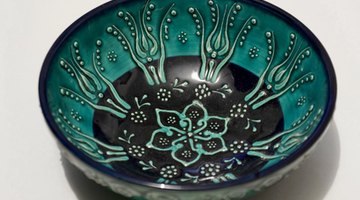How to Restore Chinese Cloisonne
Cloisonné is an intriguing product that is created by mixing glass, metal and bronze together. Chinese cloisonné is known for its beautiful designs and bright colors. Because blue is the dominant color for the enameling, it has been called the “Blue of Jingtai.

Things You Will Need
- Optical epoxy
- Airbrush
- Enamel paint
” This was during the Ming dynasty from 1450-1456 when Jingtai reigned. The creation of cloisonné is an involved and complex process that begins with base-hammering and soldering. It then progresses to the filling and firing of the enamel. The next stage involves the polishing process and leads to the final gilding. Cloisonné repair requires time and attention to restore such beautiful products.
The Process of Restoring Chinese Cloisonné
-
Clean dirt and glue from the surface of the ceramic and its broken pieces. Begin the tedious process of placing the ceramic sections together.
-
Squirt a thin coating of optical epoxy into the cracks and dents that is even with the surface. Make certain that it is smooth. Do this with precision and wipe away the excess. Be certain to remove any bubbles that may have formed in the holes to prevent further cracks at a later time. Do not try to manually press out the dents because this can create more cracks and damage.
-
Airbrush enamel paint on the object with gentle hand strokes to replicate the color of the first creative design and appearance. It may need several more layers for full restoration purposes. Allow drying time in between applying the layers.
References
Writer Bio
Hunter Darden is an author of four children's books, a novel, and a black-and-white photography book. She is also a humor/inspiration newspaper columnist having written for The Charlotte Observer. Darden has a degree in psychology from Meredith College. She was the 2005 recipient of the Meredith College Career Achievement Award and the NC General Federation of Women's Clubs Excellence in Creative Writing Award.
Photo Credits
- Bowl image by Jellie from Fotolia.com
- Bowl image by Jellie from Fotolia.com
More Articles



